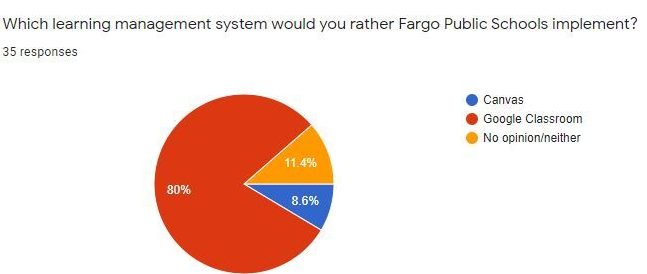Canvas Experiences Rough Roll Out Across District
October 4, 2021
Throughout the start of the school year, students and teachers alike have had an assortment of problems with our new learning management system, Canvas. So why have we switched to this new LMS, and what issues have teachers had behind the scenes?
In the spring of last year, it was officially decided that the Fargo Public Schools District would change its main LMS to Canvas, meaning the use of Google Classroom and EDUcal would be phased out by fall. This was a big decision, as the district was switching from the relatively cheap EDUcal and the free Google Classroom to the new system, which costs the district around $650,000 annually.
The roll out has been bumpy for teachers and students alike.
For the teachers, getting assignments to students has changed from a streamlined setup on Google Classroom to building a web page from a template on Canvas. While Canvas has a plethora of great tools, the choices can be overwhelming. It takes hours for teachers to set up a decent Canvas page, not to mention a developed page which utilizes all the different benefits of Canvas.
Some teachers have gone back to using more paper assignments to avoid using Canvas altogether.
Students have also faced a multitude of problems. It has been a struggle to access resources like Quizlet in the Canvas system when it used to be very simple in Google Classroom. The Canvas calendar is convoluted, making it difficult to see what assignments are actually due, and it is often a battle just to access and turn in assignments.
So why did the district switch to Canvas? We reached out to Jodell Teiken, the director of instructional resources at FPS, but she was unable to respond before deadline.
The main reason is the district-wide switch to standards-based learning. Standards-based learning is a style of teaching that many districts across the country are switching to. Instead of assigning grades on a points-based scale with A’s and F’s, standards-based learning focuses on students becoming proficient in a subject.
Standards-based learning helps students who don’t learn effectively in a strict environment and reflects how well a student is actually doing in a subject than a letter grade, which may just reflect how well a student can remember information until the test.
Canvas is marketed as a platform that is supposed to allow the integration of standards-based learning and evidence-based reporting. This year’s sixth graders across the district are learning with standards-based, and have never experienced grades-based learning. The new style of grading will follow that grade all the way through school, meaning that standards-based grading will arrive at South High School in three years.
The district decided that Google Classroom and PowerSchool did not have adequate capabilities for standard-based grading, which is how they found Canvas.
According to Bill Westrick, IT Director of Fargo Public the schools, a major reason for the switch is so everything school related can be in one place, like assignments and quizzes, but that has not come yet to fruition. Instead of dealing with Canvas, teachers have continued to rely on outside resources like Quizlet, Edpuzzle, and Google Forms instead of integrating Canvas resources into their learning plans.
While the transition to Canvas may not have been a smooth transition, Canvas does still have some assets, with a multitude of benefits for parents, including much easier access to student assignments and grades. The LMS is also used by over 1300 educational institutions around the U.S., including high-class universities like Stanford and Cornell.
While Canvas has had quite a rocky start, patience is key to taking advantage of this new and better LMS, which we may eventually discover to be something leagues ahead of any other option. But for now, we figure out how to deal with the hardships of Canvas.


